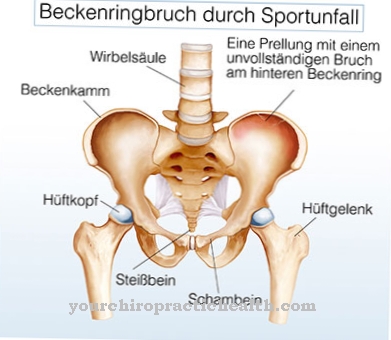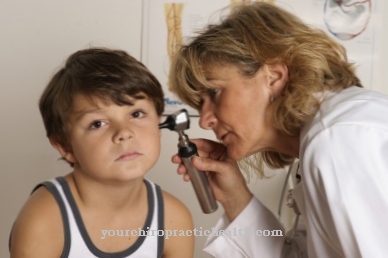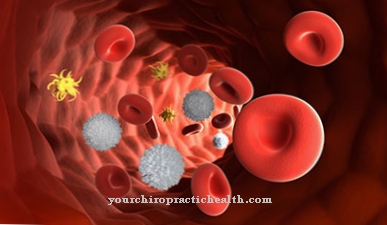Gastroschisis is a malformation of the child's abdominal wall that already arises in the womb. Due to causes that have not yet been clarified, the abdominal wall splits and internal organs penetrate outside. The disease must be treated immediately after birth.
What is gastroschisis?

© Gorodenkoff - stock.adobe.com
Gastroschisis is an abdominal wall defect that develops before birth (prenatal). The term comes from the Greek gastro = stomach, stomach and s-chismà = split and is therefore Abdominal cleft called.
In gastroschisis, a gap of about 2-3 cm through which the internal organs penetrate forms in the abdominal wall of the fetus, usually to the right of the navel, in early pregnancy. In most cases, the intestine pushes through the abdominal opening and lies in the amniotic fluid. However, other organs, such as the liver or stomach, can also fall through the gap from the abdomen.
Because the intestine then floats freely in the amniotic fluid and is not restricted by the abdominal wall, it does not develop normally.The loops of the intestine expand and the organ becomes larger than it should be. In addition, it can lead to twisting of the intestine and as a result to circulatory disorders, which in the worst case causes tissue to die. Gastroschisis is rather rare, but an increase in frequency has been observed in recent years.
causes
There is no clear explanation for the development of gastroschisis. There are different theories. One explanation assumes that the right umbilical vein, a vessel that is only present at the beginning of pregnancy and regresses later, is responsible for the disease. The job of this vein is to nourish the abdominal wall. If it regresses too early, the abdominal wall is undersupplied, tissue dies and the defect arises.
Since the intestine begins to grow at about the same time, it is pushed out of the body through the opening. This thesis would also explain why gastroschisis usually occurs to the right of the navel. Another theory suggests that the occlusion of a right-sided artery leads to a kind of tissue infarction and causes the split.
A third thesis assumes that a disorder causes vascular malformations and that the abdominal wall does not close. Finally, there is also the opinion that gastroschisis can arise from a tear in the membrane around the umbilical cord.
You can find your medication here
➔ Medicines for stomach ailments and painSymptoms, ailments & signs
Gastroschisis is manifested by a gap in the abdomen that is noticed immediately during and after the child is born. Mainly parts of the intestine emerge from this abdominal gap. These can be parts of the large or small intestine. Before the birth, the gastroschisis can be determined by ultrasound.
While the intestines are still protected before birth, serious and sometimes fatal complications occur afterwards. The intestinal loops located outside the abdominal cavity are unprotected and therefore very susceptible to infection. The infections easily develop into peritonitis, which is often very serious. Furthermore, a threatening bowel inflammation can develop, which leads to the death of parts of the bowel.
The outer loops of intestine also store fluid and therefore appear swollen. The formation of fibrin can also cause parts of the intestine to stick together. Finally, there can also be an intestinal obstruction in which large parts of the intestine die. Without treatment, gastroschisis in newborns is fatal due to the complications mentioned.
However, the disease is easy to treat surgically. The healing process can take several weeks or months. As a rule, however, the gastroschisis then heals completely. In some cases, however, there are accompanying malformations such as narrowing or atresia in the intestine, which must also be treated.
Diagnosis & course
With an ultrasound examination (sonography), gastroschisis can be detected with great certainty (90%) from the 16th week of pregnancy, sometimes even earlier. The size of the defect, how much of the intestine or which other organs have leaked out of the abdominal cavity, can also be easily identified by sonography.
If gastroschisis is suspected by the ultrasound findings, an amniotic fluid test is often carried out for further clarification. An increased AFP value (AFP is a protein) in the amniotic fluid can be a further indication of the disease, but is not considered evidence. Due to the defect in the abdominal wall, the internal organs, especially parts of the intestine, fall into the fruit cavity and swim freely in the amniotic fluid.
The intestinal loops grow strongly due to the lack of limitation and are swollen (edematous). If the intestine is twisted, it can lead to circulatory disorders and thereby to the death of intestinal tissue. In addition, the amniotic fluid is burdened by the excretions of the fetus.
In specialized clinics, the amniotic fluid is exchanged in rare cases when the concentration of waste materials is too high. Gastroschisis must be closely monitored during pregnancy. Both the maturity of the child and the extent of the organ damage are always kept in mind.
Complications
In the worst case scenario, gastroschisis can lead to the death of the child if the disease is not treated immediately after birth. In most cases, however, a very early diagnosis is possible so that treatment can be started immediately after the birth. In this way, consequential damage and further complications can be avoided.
If the intestine is twisted, the intestinal tissue can die because it is no longer properly supplied with blood. Other organs can also be damaged. The damage depends strongly on the severity of the gastroschisis. As a rule, regular check-ups are necessary in order to permanently observe the damage.
In most cases, the treatment involves surgery. During this procedure, the intestine is turned back again so that there are no complications and the tissue does not die. Other damage to organs may also need to be examined and treated. In most cases, the child's disease progression will be positive if treatment is given immediately after birth. There are no further complications.
When should you go to the doctor?
Expectant mothers should generally take part in the pregnancy examinations offered. A large number of irregularities or diseases in the unborn child can be detected during the medical checks. In the second trimester, gastroschisis can already be safely diagnosed by a gynecologist. It is therefore advisable to use the ultrasound examinations from this point on. If an inpatient birth takes place, various examinations of mother and child are routinely carried out immediately after the birth.
Intervention by relatives is therefore no longer necessary in most cases at this point. Often a caesarean section is performed due to the detected gastroschisis, so that the child receives immediate medical care in the clinic. If an unscheduled home birth takes place, a doctor must be called in for a home visit during the birth or the emergency services must be informed. Even if the disease was not noticed during pregnancy, a doctor should always be consulted immediately after a home birth.
In general, a pregnant woman should consult a doctor as soon as she has a vague feeling that something might be wrong with her growing child. Apart from participating in the check-ups, it is important that you consult your doctor if you notice any irregularities, a general feeling of illness or other abnormalities.
Doctors & therapists in your area
Treatment & Therapy
The possibility of treating gastroschisis only sets in after the birth. Usually, a caesarean section (Caesarean section) is recommended, but practice has not shown a clear advantage over normal vaginal birth. The only possible therapy for the defect is a surgical procedure, which should be carried out shortly after the birth, at the latest 18 hours afterwards. The first treatment consists in turning back a possibly twisted bowel (derotated).
The infant is placed on its side so that no vessels become blocked. Furthermore, the child's body is wrapped in a sterile plastic sleeve so that the external organs do not dry out and the infant stays warm. A nasogastric tube and venous access are placed in order to be able to supply the body with medication and food. During the operation, the organs are examined for tissue damage and, if possible, returned to the abdominal cavity. This operation is called primary closure.
However, if the organs are too large, they would not find enough space in the baby's abdominal cavity. This would lead to excessive pressure, which in turn affects blood vessels and organs, causes circulatory disorders and can affect the heart. In this case, a so-called multi-stage shutter is used.
The organs are placed in a bag over the abdominal wall defect. This pouch is gradually reduced in size, which slowly pushes the organs into the abdominal cavity. Finally, the abdominal cavity is closed. This method prevents the excessive pressure increase.
Outlook & forecast
If left untreated, gastroschisis leads to an unfavorable course of the disease. Immediately after the birth, the patient must be given adequate medical care to ensure the survival of the person concerned.
Although a diagnosis can already be made in the womb and is carried out through an amniotic fluid test, treatment can only take place after the birth. The malformation is corrected in a surgical procedure. This ensures that the intestines can function properly. If the operation takes place without further complications, the patient is then considered cured.
There are multiple check-ups, especially in the first weeks and months of life. The intestinal activity and blood flow are clarified. If no complaints arise, no further measures are required.
If there are complications or inflammation in the abdomen, the healing process is delayed. In severe cases, the infant will continue to be hospitalized until the state of health is stable, so that no equipment is required. Tissue damage can occur or a nasogastric tube is misplaced. Only in very rare cases is the damage to the organs so severe that further interventions are necessary. It is more likely that a bag will be used, which is used to position and move the organs to their destination.
You can find your medication here
➔ Medicines for stomach ailments and painprevention
There are no preventive measures against gastroschisis. However, early diagnosis is important. This allows the child's development and the severity of the disease to be monitored, which ultimately increases the success of postnatal treatment.
Aftercare
Gastroschisis cannot be treated with follow-up measures. The affected person is dependent on direct and above all on early treatment in order to avoid further complaints or even the death of the child. The treatment of gastroschisis therefore usually takes place immediately after birth.
The child is operated on, with the organs being put back into position. In most cases, there are no particular complications or other complaints if the gastroschisis is recognized directly before birth. The parents concerned need special support.
Above all, the care and support from friends and family is very helpful and necessary. Psychotic support in particular can be useful. In serious cases or if the child dies from gastroschisis, professional psychological counseling can also be sought.
The child needs to rest after the procedure and should not be exposed to any special or strenuous activities. As a rule, regular examinations by a doctor are necessary even after the procedure. If the treatment of gastroschisis is successful, the life expectancy of the person affected is usually not reduced.
You can do that yourself
Regular check-ups by the pediatrician are indicated after the operation. The doctor will inform the parents of the exact time intervals and also inform them of the reasons for extraordinary examinations. Basically, children who have gastroschisis must be examined weekly in the first few weeks and months in order to ensure proper wound healing and to detect any complications at an early stage.
Further hygiene measures are required when dealing with the child. All utensils (e.g. bottles and dishes) and items of clothing should be boiled out after use. The surgical wound itself must be treated according to the pediatrician's instructions. Parents are also advised to seek professional advice from a specialist in early childhood malformations. Comprehensive discussions can better understand the disease and ultimately make it easier to deal with it.
Should the gastroschisis cause problems in later life and, for example, dysfunction of the gastrointestinal tract, a doctor must be consulted. Later, the child must be informed about the malformation, as the visible scars will make them ask questions anyway. Under certain circumstances, accompanying advice from a doctor or a therapist is useful.

.jpg)




.jpg)






.jpg)

.jpg)
.jpg)











.jpg)